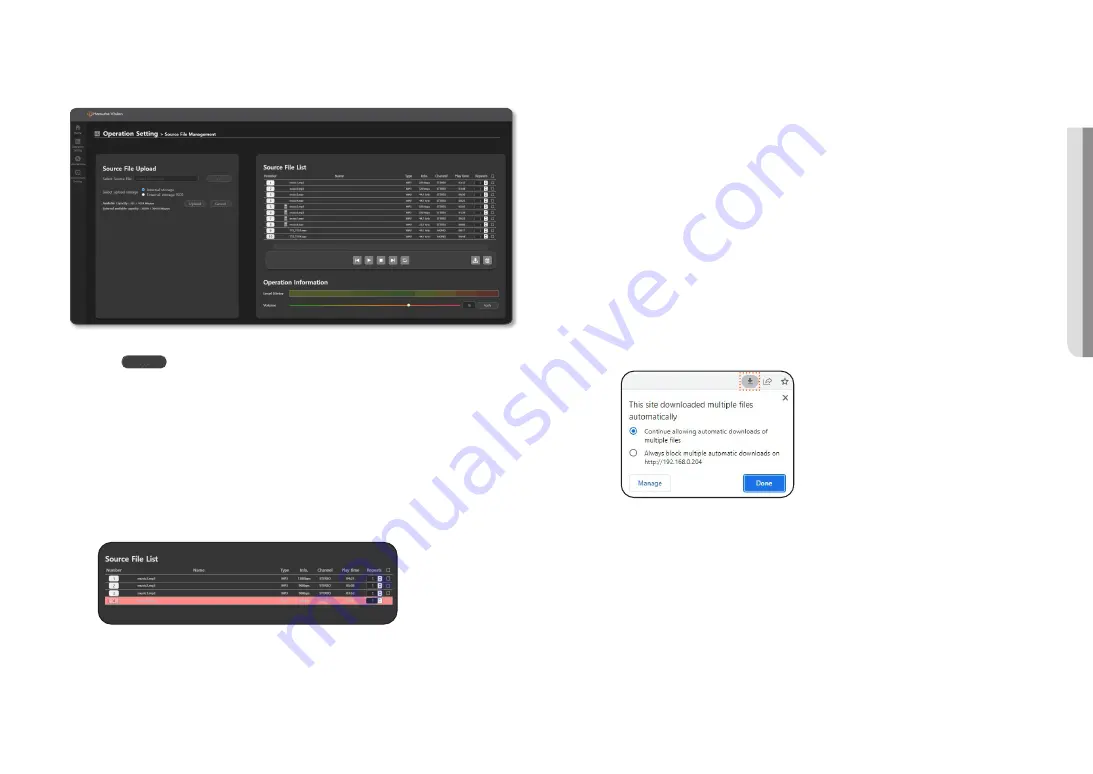
English _
41
!
USING SPEAKER MODE
Source File Management
You can register an audio file for broadcasting.
1.
On the Home screen, click <
Operation Setting
>
➔
<
Source File Management
>.
2.
Click the [
] button to select the PC folder containing the sound source files to be uploaded.
M
`
The internal storage has an available capacity of up to 1GBytes, and there are no restrictions on the size and number of
sound files within the capacity.
`
Supported source types: WAV (16bit), MP3
`
Supported MP3 bit rates: Only MP3 (mono/stereo) in the range of 64kbps to 320kbps
`
Supported WAV Sampling Rate: 16Khz, 32Khz, 44.1Khz, 48Khz
`
PCM-type WAV files without header information cannot be used.
`
If the sound source file name contains special characters, it may not be uploaded.
Please change the file name (remove special characters) and upload again.
`
Please delete audio files which cannot be played as they will be displayed as “unable to use” on the screen if they are
uploaded or played.
3.
Click the [
Upload
] button after selecting source files to upload.
~
You can select External Storage (SD) and upload if the product has a microSD card.
~
The available capacity of the internal and external storage is displayed and an upload unavailable
window appears when they are smaller than the source files to be uploaded.
~
Insert or remove the microSD card while the product is turned off.
~
Duplicate sound source file names are not allowed, so a pop-up window will appear saying that it
cannot be uploaded.
M
`
Be sure to format the microSD card in FAT32 (file system) before inserting it into the speaker.
`
NTFS and exFAT (file systems) are not supported.
`
A microSD card capacity of up to 32 GB is supported (SDHC, MLC, Class 10 or higher).
`
We recommend Sandisk and Transcend products.
`
Compatibility by manufacturer and product type may vary.
4.
Uploaded source files are displayed on the right <
Source File List
>.
Various information is provided, and repeated playback of audio (up to 99 times) is also possible.
~
A microSD card icon is displayed with the file name for the files saved to external storage (SD)
~
The TTS file (TTS_filename.wav) for which the <
To BGM
> function was used in [
TTS File Management
]
is also displayed in the <
Source File List
>.
5.
You can download the uploaded sound source (except for the To BGM TTS file) or delete it.
M
`
When you try to download two or more audio resources, the pop-up window granting permission will appear.
If you have pressed the permission-block button, click the top right button on the web page (shown with the icon) to select
<
Allow downloading multiple files automatically
>.
6.
Play/pause, stop, previous song/next song (select multiple sound sources), repeat are possible.
When audio is played, its title will be shown as it scrolls across the screen.
M
`
If the speaker is turned off and on while a sound source is playing, it automatically plays from the beginning.
`
During the sound source play, if the PAUSE button is pressed to pause playback or the STOP button is pressed to stop
playback, auto play does not work.
7.
The output volume is reflected only to <
Source File Management
>.
If you run mute from the <
Device Monitoring
>
➔
<
Output Device
> of the server or controller mode
speaker, the mute is also applied to Source File Management.
8.
When the file is played, the audio title and level meter can be used to check it.
9.
Click the number of the source file list to play through the PC speaker.
Содержание SPA-C100W
Страница 52: ......


























